This is one of the few images I've taken for the asteroid. A friend who was a fan of Skepicality asked me to get the asteroids named for the hosts at the time. A quick check turned up an asteroid named for Derek Colanduno. I had to track down Swoopy's name and found she too had an asteroid. This is the one for Derek. Unfortunately, it was in the heart of the Milky Way right under the jaw of the very large dark nebula sometimes called the Horse Nebula. This made it hard to find and invisible on raw frames until calibrated. It didn't help that the Minor Planet Center had the position a bit wrong so I centered incorrectly. Fortunately, their ephemeris service had the position correct so I was able to find it and mark it in the cropped annotated image. Being at -23 degrees and thus partly behind my observatory wall stars are fainter than normal and distorted by being so low in the sky as well as the diffraction effects of the wall. I've included a full frame so you can see how hard finding asteroids in the Milky Way is. I've also included a 2x blowup of the region in which his and two other asteroids were lurking. Colanduno is circled in red. The other two in blue. They are (180111) 2003 FB28 at magnitude 19.5 and (67328) 2000 HK77 at magnitude 18.3 to the upper right. Colanduno is at an estimated 19.4 magnitude so pretty faint. Normally I'd have the mount track the asteroid to build up a brighter image of the asteroid rather than letting it trail but with the star packed field I was afraid star trails would cover it up. See my page for McCarthy for his co-host "Swoopy's" asteroid. It was easier to take not being in such a stary field.
The naming convention reads:
(106545) Colanduno = 2000 WL68
Derek Colanduno produces and co-hosts Skepticality, a podcast talk show that reports science news and comments critically on urban legends and pseudoscience. His work has promoted science and informed thousands of listeners.
This image was taken June 23, 2009.
14" LX200R @ f/10, L=5x10' RGB=1x10', STL-11000XM, Paramount ME
| 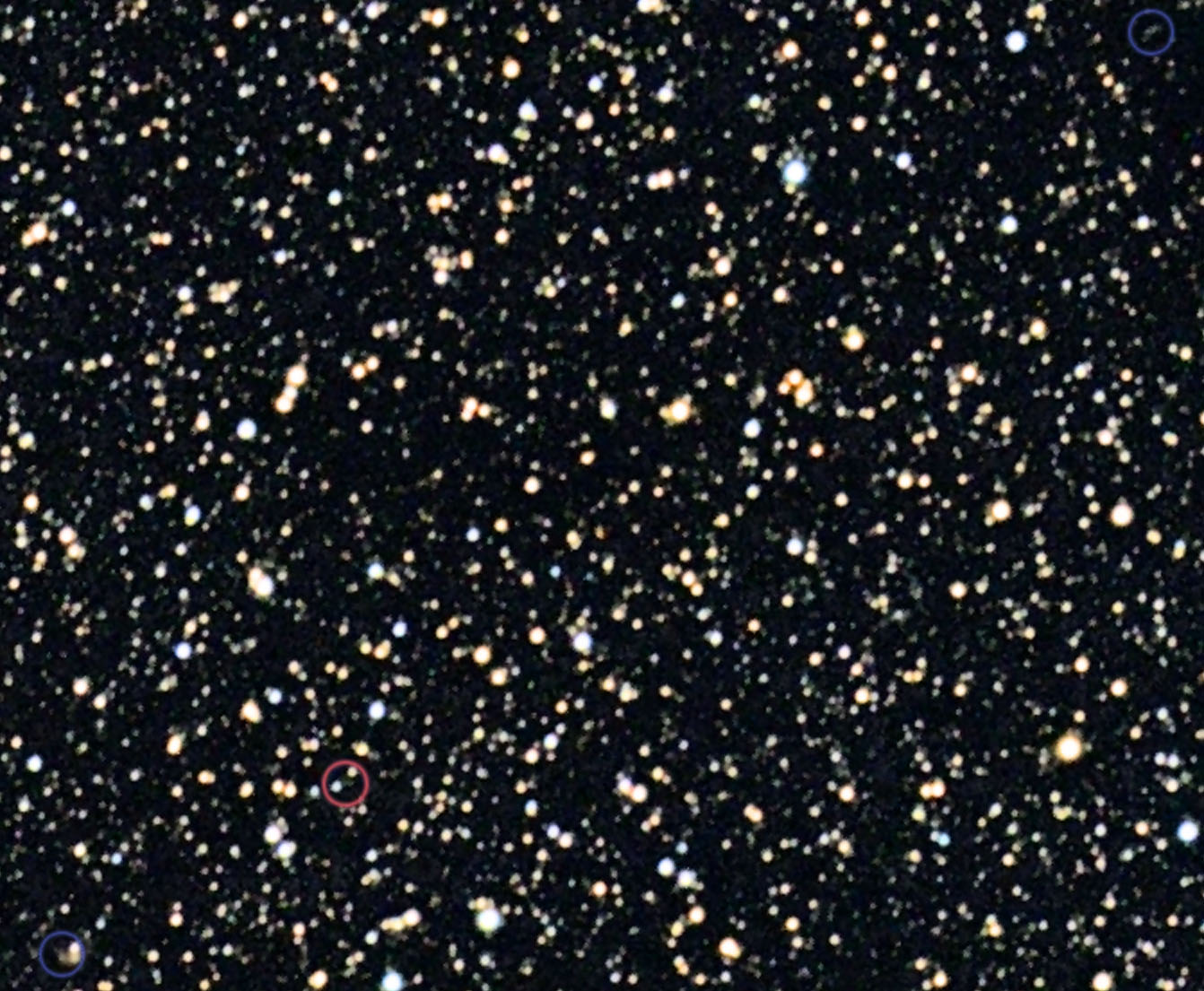
COLANDUNO-ID-2X.jpg
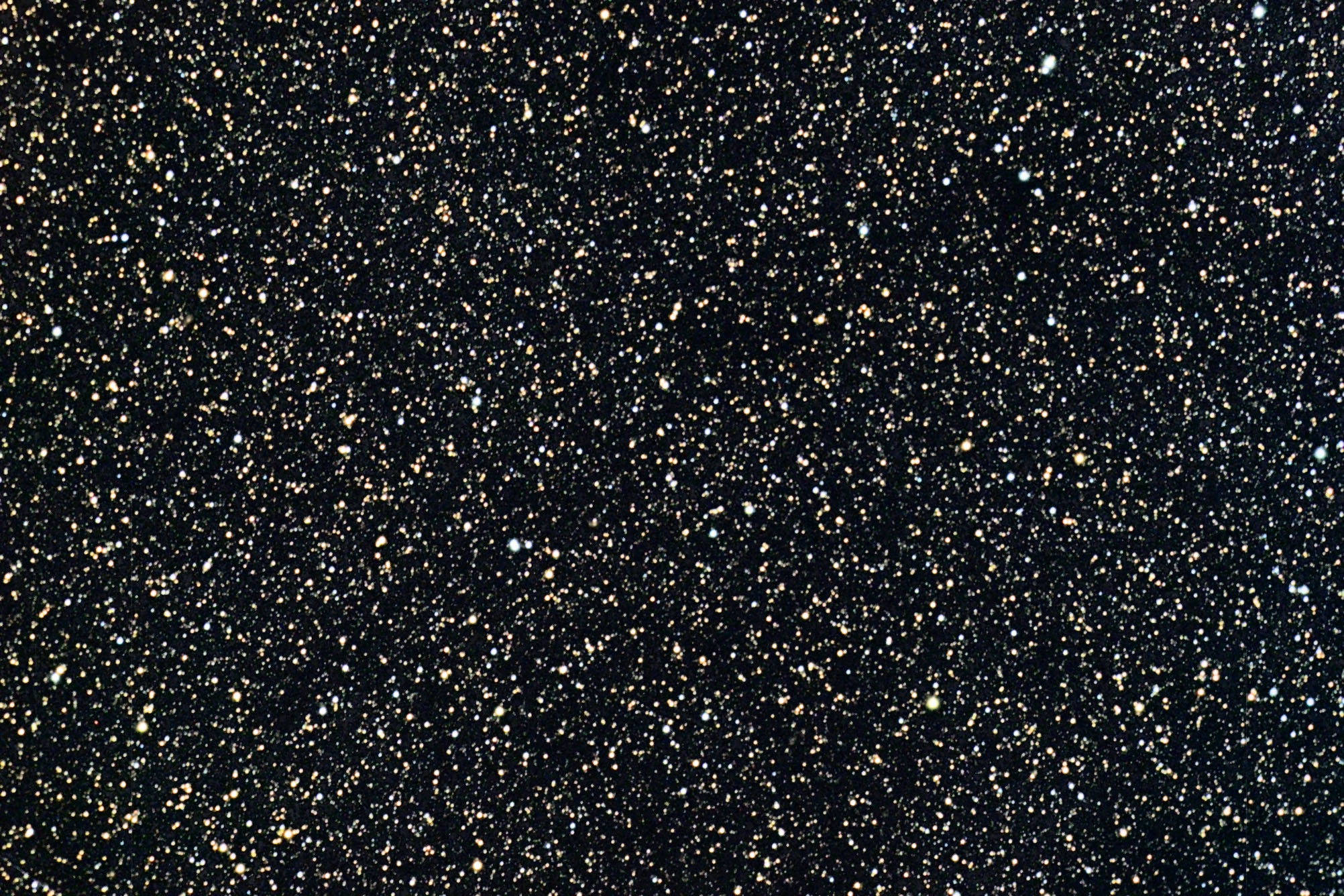
COLANDUNO.jpg
| Collinder 21, located in Triangulum, is a group of rather bright stars that make a good "cluster" for small telescopes. Most sources, however, say it is just an asterism rather than a true star cluster. That is, it is just some bright, unrelated stars that happen to appear close together due to our perspective. Viewed from a different angle the appearance of a cluster would vanish. But since it has a couple interesting galaxies I decided to put it on my to-do list. Being bright I took it on a very poor night with lots of clouds. This caused some nasty halos of various colors around the bright stars. Instead of a quick and easy object to process, it was quite difficult. While I initially balanced the star colors with eXcalibrator by the time I got done dealing with the halos I'll only claim the colors to be in the ballpark of correct. The bright star at the south end of the group is SAO 74965 a double star with a separation of only 0.32". Thus, it appears as a single F5 star of 8.15 magnitude in my image according to TheSky. I saturated the star so can't measure it. I'll have to take TheSky's word for it. It places it at a distance of 562 light-years. The distance to the lower of the pair of stars on the right side of the group is 1553 light-years according to TheSky. TheSky places the red star at the top of the group at only 105 light-years. It doesn't have distance data on any others in the group. Still, this is sufficient to show it isn't a true cluster. After going though this I found this paper doing a complete analysis of the group, and two others, thinking they were clusters being torn apart but found they are all just asterisms. https://arxiv.org/abs/astro-ph/0407605
Only two galaxies in the image had redshift data. IC 1731 at the top is about 150 million light-years distant by redshift and 130 million by other methods. NSA 130512 at 640 million light-years by redshift is at the very top of my image with its upper part out of the frame. Being near the Zone of Avoidance there's little on the field. Everything NED had is noted in the annotated image -- not much. I was disappointed that the apparent rather large, distant galaxy cluster left of IC 1731 wasn't listed. It sure looks interesting. IC 1731 was discovered by Isaac Roberts on November 29, 1896.
Just NW of this image is the pair of galaxies, NGC 0672 and IC 1727 which I've already taken. My field is just too small. The two images don't quite overlap so I couldn't make a mosaic. They are far more interesting than those in this image but there's no bright asterism in their image.
14" LX200R @ f/10, L=4x10' RGB=2x10', STL-11000XM, Paramount ME | 
COLLINDER21L4X10RGB2X10.JPG

COLLINDER21L4X10RGB2X10ID.JPG
| Without much time before dawn started I decided to try for Lulin. But no sooner was I set up and the cloud alarm started screaming. The image wasn't all that bad so why? Turns out it was snowing! I stepped outside and could see stars down to about magnitude 2.5 rather than the normal 6.5 but fine snow was also falling. Since it was coming from the north I decided to try and get something of Lulin. I didn't get much as the clouds made the tails invisible and out of 2 hours of data collection only 6 minutes of star data and 6 minutes of comet data was usable as the clouds kept getting too thick. So I didn't get much.
When processing a fast-moving comet the best way of doing it is to process the stars and comet separately. This one is moving so fast after taking an hour of comet data the area of stars it was in was clear of the comet so I went back and took the star field. Then I processed the comet to remove the stars, which were long trails as I was tracking the comet's orbital path. No guide scope, I just program in the orbital elements of the comet and the mount tracks based on that data. You need very accurate polar alignment but I have that. Adding to my blood pressure is that the cloud sensor runs whenever the roof is open so it was screaming the whole time. Not only was the beeper and warning horn going off a computer voice was saying Uh-Oh! every few seconds. I wired it to always be on when the observatory was open I didn't forget to turn it on when the observatory was open. I'm rethinking that!
It's amazing with only 6 minutes of data through clouds I was able to get much of anything of the comet. This is a pure RGB image, no luminance data was taken due to the clouds. Star color is weak due to lack of color data. A faint hint of the dust tail to the left is visible. All the rest was lost to the weather. Image scale is 1.5" of arc per pixel. The galaxy in the comet toward the left is 2MASX J12414465-0415545, an unclassified galaxy of magnitude 15.7 at 875 million light years per redshift data. In a normal exposure it would be big and bright but thanks to the clouds it is barely seen.
14" LX200R @ f/10, RGB=2x10', STL-11000XM, Paramount ME | 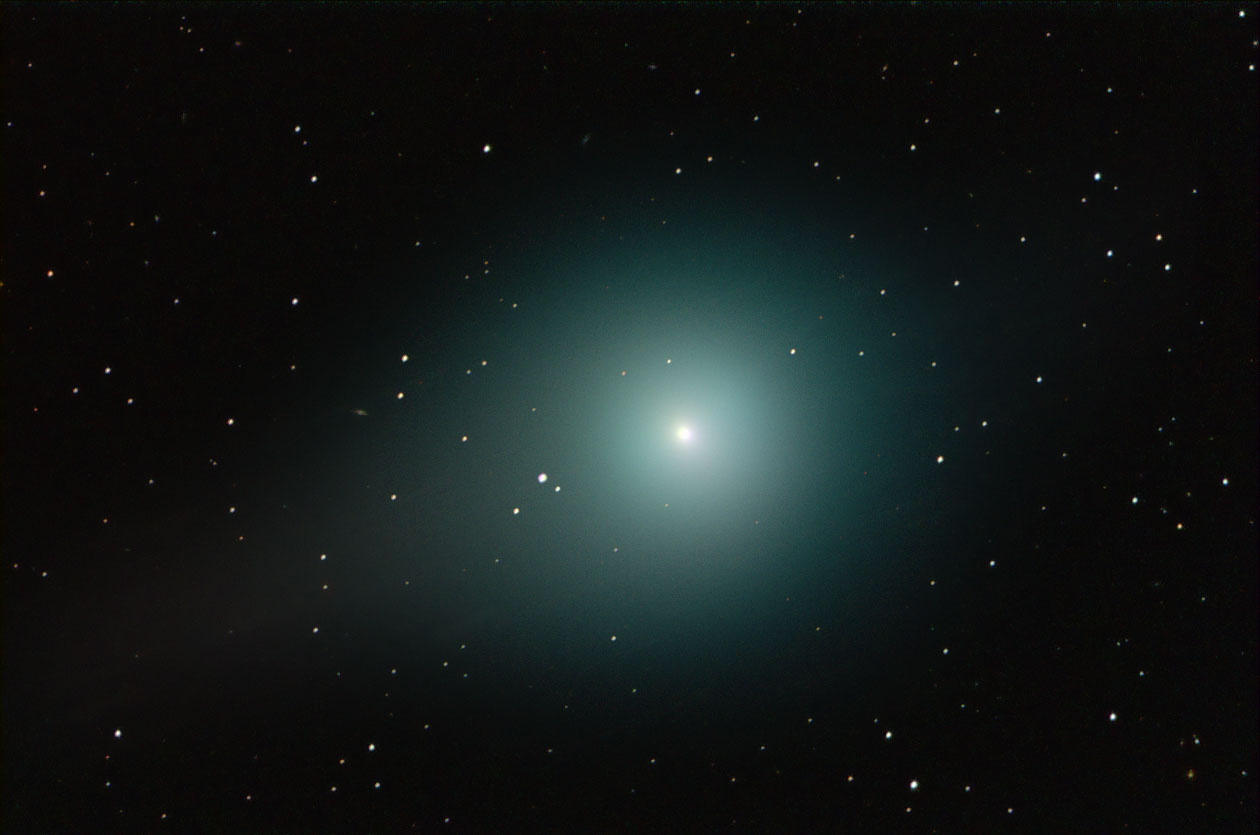
LULIN.jpg
| After months of nothing but clouds in the early morning, I finally was able to again image Comet Garradd (C/2009 P1). Though I missed it passing M92 due to the weather both wouldn't have fit my small field of view. Though then the two tails were at an odd obtuse angle. On the 18th of February when I took this image they were almost exactly 180 degrees apart with the dusty anti-tail fading rapidly as we are no longer looking at it in plane. I wanted to catch that on the 15th but clouds prevailed!
Oddly the anti-tail came out rather reddish in color in my image. Usually, they are pretty colorless. The blue gas tail to the west does have the right color. The green is due to carbon compounds commonly found in comet's coma.
I sort of cheated for this image. I used 30 one minute luminance images and 10 one minute images in each color. This didn't result in a very good star-field. Just too much read noise in all those images. So the 19th I revisited the star-field centering on the same position as the previous night. I took my usual 40 minutes of L and 20 of each color but come morning I found the sky went to pot. Fortunately, I took the images 2 L then 1 of each color then repeated the process. That meant I had half the data at least as it went bad someplace in the second round's first luminance frame. This was deeper than the one minute shots of the previous night with better color even if the time for the L channel was less and color the same. I then processed the comet after removing the stars and pasted the starless comet into the star-field carefully placing it where it was when the first L image was started on the 18th.
At the time the comet was imaged Garradd was 1.343 AU (125 million miles) from the earth and 1.734 AU (161 million miles) from the sun. To show this big at that distance it is one big comet. Odd the lunatic fringe decided far fainter and smaller Elenin would do us great harm yet totally ignored this comet which was even more well known at the time. Anyway, it is still "big and bright" though I needed 8x20 binoculars to see it. It is heading northwest west of the head of Draco. By month's end it will be moving in Ursa Minor below the bowl of the "Little Dipper."
While quite a few galaxies are visible in my image, NED had redshift data on only one. It is the largest in the field seen below the gas tail on the right side of the image. It is UGC 10493 with a redshift of z=0.030114. This puts it a bit over 400 million light-years from us.
14" LX200R @ f/10, comet: L=30x1' RGB=10x1', Stars: L=2x10' RGB=1x10', STL-11000XM, Paramount ME | 
GARRADD_L2X10RGB1X10_L30X1RGB10X1R-67.JPG
| I'm late with this one. Processing it gave me fits. Normally I find it easy to remove the stars with a data rejection stacking once the images are aligned on the comet's core. I found that impossible due to the dense star background. Getting rid of the comet is easy with a gradient tool and a bit of cloning out what little remains. I finally got rid of the stars in the luminance frame but the color frame was far more difficult. I lost a lot of the tail doing so. It went into M71. After days of much swearing, I finally managed something.
I debated on how to handle the ton of stars seen through the comet's tail. I ended up blocking the vast majority of the faint ones. Just detracted too much from the comet. So only the brighter were allowed to show with the fainter ones masked out in the star field image.
This one seems to be a case of too much aperture picking up too many stars.
Comet's color wasn't nearly as strong as on some other posted images. Probably needed more color but the clouds had other ideas, unfortunately.
14" LX200R @ f/10, L=30x1' RGB=10x1', STL-11000XM, Paramount ME | 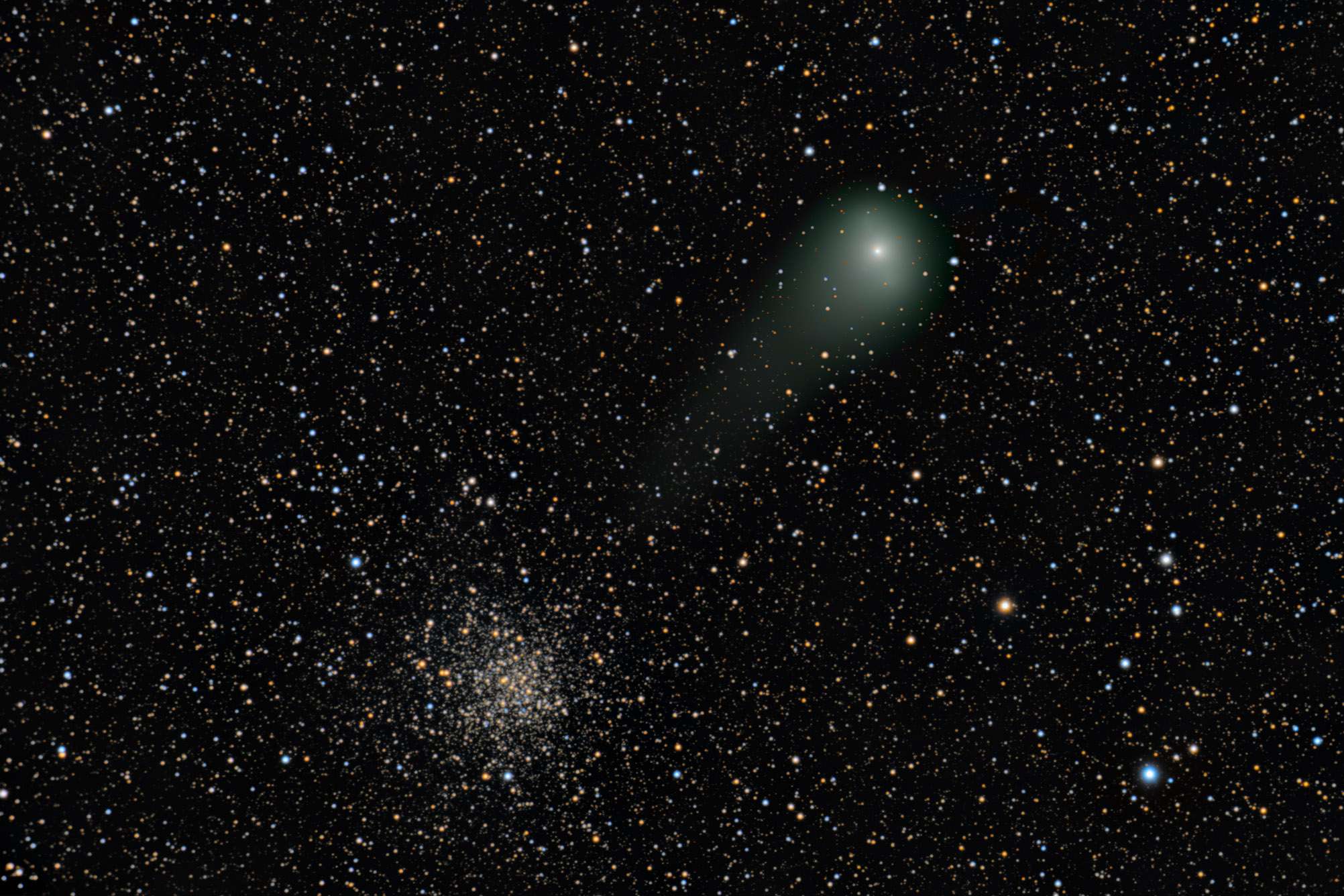
GARRADD-L30X1RGB10X1r.jpg
| Czernik 40 is an open cluster in southwestern Vulpecula. It is about 10,000 light-years distant and thought to be about 800 million years old. Old enough that most of its big blue stars have long since died leaving only white to red stars. Also it 10,000 light-years it is reddened by virtually a full magnitude. But likely, so are many of the background stars so it doesn't appear much different than the background stars in color.
This is another WAG for color as the smoke really did a number on all the data. I was able to only get one usable color image for each color and the red frame was 3 times the intensity of the green and blue frames. I tried other nights but the results were even worse so went with the first try's data. I assume there was something about the smoke particle size that allowed red to come through nearly perfectly and hurt blue and green about the same. I'd have expected blue to be hit harder than green but that didn't happen. It could be the smoke varied and green had less than blue. As to luminance I have no idea if the red stars were allowed through much stronger than the blue and green as was in the color data. I took the luminance after the color data though I took red first. While the hit on luminance wouldn't alter star color it would alter intensity with red stars coming through big and bright. Though to the eye, the difference between red and blue stars is hard to see unless they are of somewhat equal brightness and side-by-side like Alberio, Iota Cancer and similar double stars. BTW I see it just announced that GAIA has shown Alberio to be a line of sight double not an orbiting pair. That question is finally put to rest. That small difference may have saved the relative intensity of the various colored stars.
With the huge adjustment to bring red into line with green and blue and finding no color images of this field, I can't guarantee the colors are right, just that they are colored. With only one frame for red and it picking up a nasty satellite, I had a problem. It passed right over many dozen stars and cloning it out would also severely hurt stars with my ham-handed cloning. After much thought, I found a way to get rid of it and not use cloning. I selected the stars in the RGB image then inverted the selection. So now everything not a star was selected. Since the only things now selected were the background and the satellite trail I could neutralize the satellite and background. The trail vanished like magic. I think a really bright trail would have been a problem but this one was eliminated. Satellites in the green filter can be removed, even when bright, with the Hasta La Vista Green filter. I'm now often not taking two green because the HLVG filter makes trails in that filter easy to deal with. I suspect blue trails if not too strong can be handled as the red was. Brighter ones will still need two frames I suspect. At least this gave me a new tool to use.
There's nothing else in the field so I didn't make an annotated image. Also since smoke killed seeing and because there's no need for high resolution I am reproducing this one at 1.5" per pixel rather than my usual 1" per pixel -- when viewed full size.
14" LX200R @ f/10, L=4x10' RGB=1x10, STL-11000XM, Paramount ME
Rick | 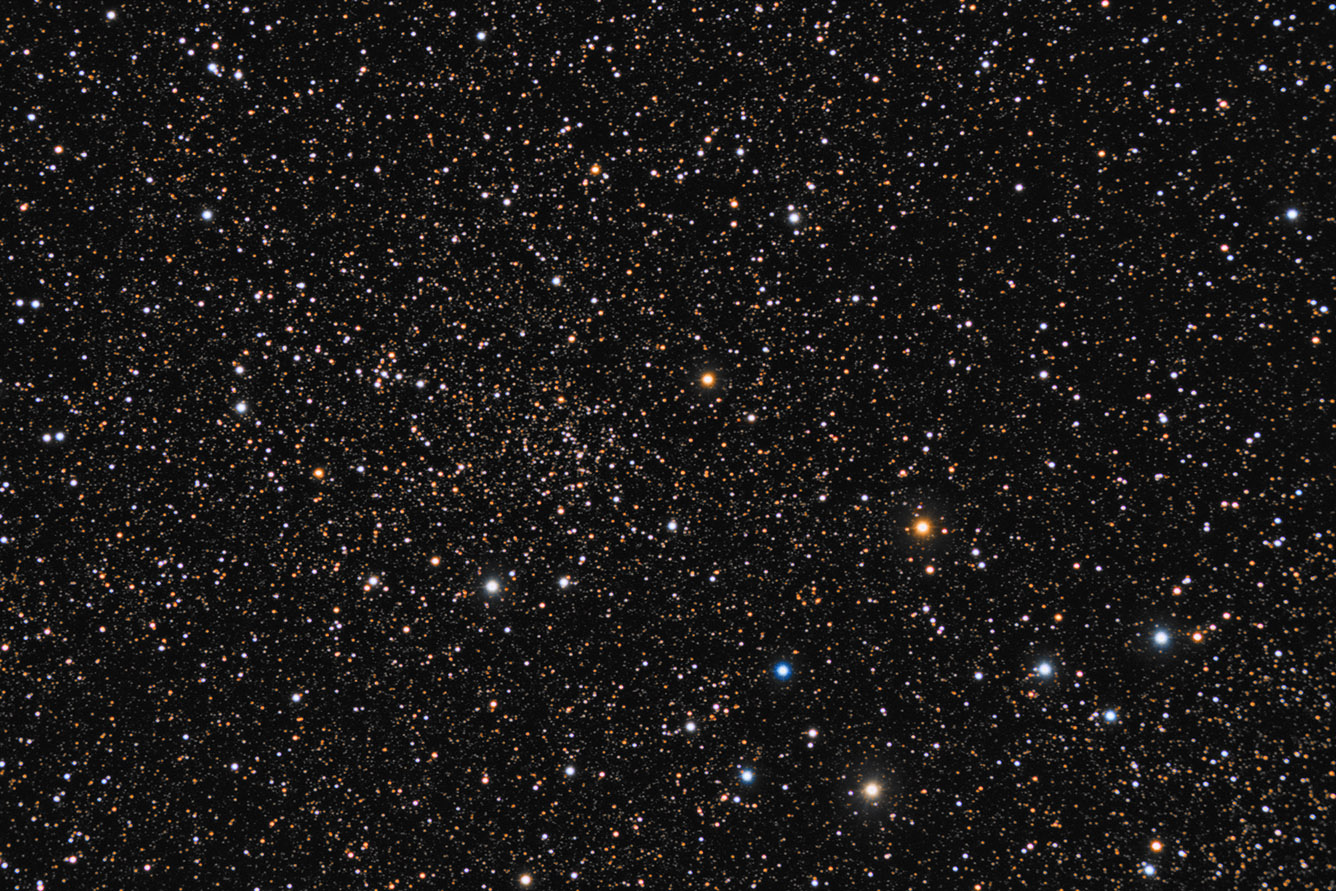
CZERNIK40L6X10RGB1X10-67.JPG
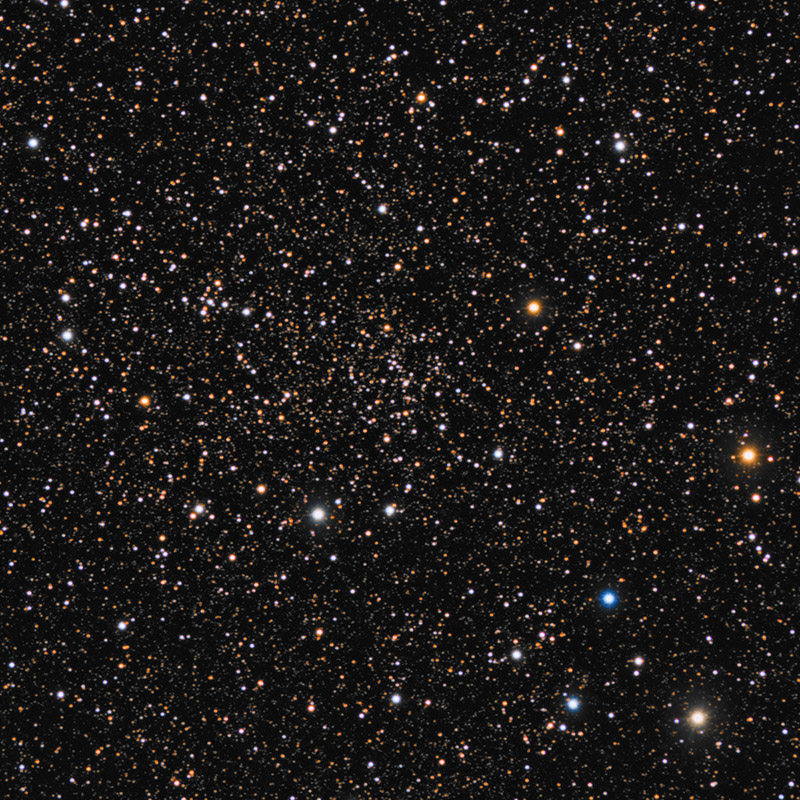
CZERNIK40L6X10RGB1X10CROP-67.JPG
| This is a retake of an image taken in the fall of 2011. Conditions were very poor then so I wanted to retry it. I took data over three nights in December 2012 but conditions stayed very poor. At -11 degrees this one isn't easy even on a good night. Seeing was much better though again sky brightness was very high due to haze and nasty airglow. Again the fainter details escaped me. But thanks to better seeing it is a noticeable improvement over the previous year. Most of the text below is from the original post which is at: http://www.spacebanter.com/attachment.php?attachmentid=4373&stc=1 .
DDO 005/PGC 2689 is a strange galaxy near the right edge of my image. A note at NED shows lots of confusion about this galaxy in the MCG catalog (it is MCG -02-03-009). It reads: "Interacting? Perturbed SB? -- On the arm is a nucleus or a star, and also a compact E or star [16 mag] is found in it." The 16th magnitude object appears to be a star in my image judging by its PSF (Point Spread Function). The 18th magnitude object to the upper right, however, is not a star nor is the blue object below the 16th magnitude star. To me, both are star knots in a very disturbed looking galaxy. They are very common in such galaxies. I had expected it to be classed as an irregular galaxy but NED say it is a barred spiral classing it as SAB(s)m but of the Magellanic type (named for the Magellanic Clouds.) The DDO is the David Dunlop Observatory Catalogue of dwarf galaxies, most of which have low surface brightness.
The other main galaxy in this field is NGC 255 on the far left. Tully-Fisher measurements of the distances to these galaxies say both are about 65 million light-years away. Redshift measurements are in close agreement at 60 million light-years. Thus, while widely separated in my image, their projected separation is only about 500,000 light-years. It is quite possible they have interacted in the past. This could explain their appearance. NGC 255 is listed as SAB(rs)bc by NED and the NGC Project. It has a bright core region and widely spread very low surface brightness outer arms. It was discovered by William Herschel on November 27, 1785. It isn't in either H400 observing program.
This pair is located less than a half degree north of NGC 246, the Skull Nebula. So you've likely had it in your field of view when looking at this rather famous planetary nebula at low power.
There's another pair of probably related galaxies in the image. The spiral MCG -02-03-013 at the top of my image and LEDA 966142, the disk galaxy well below it. They have a redshift light travel time distance of 750 and 710 million light-years respectively. I found no other estimates of their distances. While a 40 million light-year difference may seem big this may be more to do with their relative velocities than a true distance difference. Or they just happen to be line of sight.
An apparent galaxy cluster is seen to the upper left of NGC 255. NED lists the 2MASS galaxies in the area but gives no indication that this is a cataloged group nor are there any distance estimates for them. Unfortunately, this is a very poorly researched area of the sky.
As mentioned I didn't begin to get the data I wanted and after a month of trying I gave up on it. I had to throw out about 70% of the frames as they hurt more than they helped. Satellites were nasty as well. Some frames had up to 3. One of the two usable red frames had three. With so few frames and some going right through detail in galaxies I had a lot of work removing them since I had to preserve the detail in NGC 255 and DDO 005 meaning cloning was not an option. I had to do a manual version of a rejection stack in Photoshop with only 2 color frames to work with. Lots of "fun" for a not so hot image.
14" LX200R @ f/10, L=5x10' RG=2x10' B=3x10', STL-11000XM, Paramount ME Related Designations for DDO005DDO 005, MCG -02-03-009, [RC2] A0043-11, APMUKS(BJ) B004331.99-114640.0, HIPASS J0046-11, PGC 002689, NGC 0255, MCG -02-03-017, 2MASX J00474730-1128073, 2MASS J00474726-1128077, GALEXASC J004747.22-112806.7 , IRAS 00452-1144, IRAS F00452-1144, AKARI J0047471-112807, CGS 131, 6dF J0047472-112807, 6dF J0047473-112807, LDCE 0041 NED004, APMUKS(BJ) B004516.60-114424.4, HIPASS J0047-11, PGC 002802, NVSS J004747-112803, DDO005, NGC0255, | 
PGC02689L5X10RG2X10B3X10-ID.JPG

PGC02689L5X10RG2X10B3X10.JPG
| DDO 103 is a highly disrupted blue ring galaxy of the irregular Magellanic classification in the northwestern corner of Corvus which puts it at the very edge of my southern range where a quality image is extremely rare. Unfortunately the one and only usable April night left a lot to be desired so I didn't do as well with it as I'd have liked. The UGCA says of it: "Peculiar, disturbed? Strongly asymmetric in blue light, thin streamer northwards from center, bright core; blue condensation at tip of arm." The CGPG says: "Blue post-eruptive irregular galaxy with several knots and blue filaments." The MCG says "Interacting. Hard to see any structure. Possibly there are four galaxies to the south, one [18 mag] F+E in contact, F, i=IV to the north with a nucleus in connected arms." Makes you wonder if they are talking about the same galaxy. In any case, it is plenty strange and likely the result of a merger of some sort. Its distance is about 200 million light-years by redshift measurement. With plumes, it is about 75,000 light-years in diameter.
I placed DDO 103 high in the field because I wanted to pick up DDO 104 as well. It too is very strange. A comment at NED reads: "Perhaps a pair?" Indeed it does have two bright regions at either end of an elongated blue object. NED classifies it as IB(s)m pec: and shows a redshift distance of 110 million light-years indicating it is not at all related to DDO 103. It measures only about 33,000 light-years across in my image assuming the redshift distance.
I often see references in amateur literature that the DDO (David Dunlop Observatory) catalog is a catalog of blue dwarf galaxies. Thus some question if DDO 103 belongs. It does as the DDO is a catalog of blue low surface brightness galaxies. Not dwarf galaxies. Apparently, the fact that many low surface brightness blue galaxies are dwarfs has caused some to make this mistake.
The only other galaxy with redshift data in the image is LEDA 157146 at the far right of my image. NED has no classification for it. Its distance is almost 520 million light-years. While the smallest of the three in angular size it is actually the largest at a bit over 100,000 light-years. I found little else on it.
I moved the above three galaxies to the right to catch the small somewhat double looking blue galaxy at the far left. I was surprised to find it isn't even listed as a galaxy by NED. The only designation it has for it comes from the GALEX satellite's catalog of Ultraviolet sources. NED includes these without classifying them further. Most are just hot stars, some are galaxies and a few are quasars. This one is obviously one or two galaxies but since the catalog is simply a listing I have nothing more on it. Is it one or two objects? If two are they interacting or only a line of sight pair? With nothing to go on and no redshift data, I have no idea what I've captured here. Likely two blue galaxies but beyond hat it's all surmise.
A couple of other galaxies in the field are listed in the 2MASS but again without redshift data. With so little, I didn't bother with an annotated image.
14" LX200R @ f/10, L=4x10' RGB=1x20', STL-11000XM, Paramount ME | 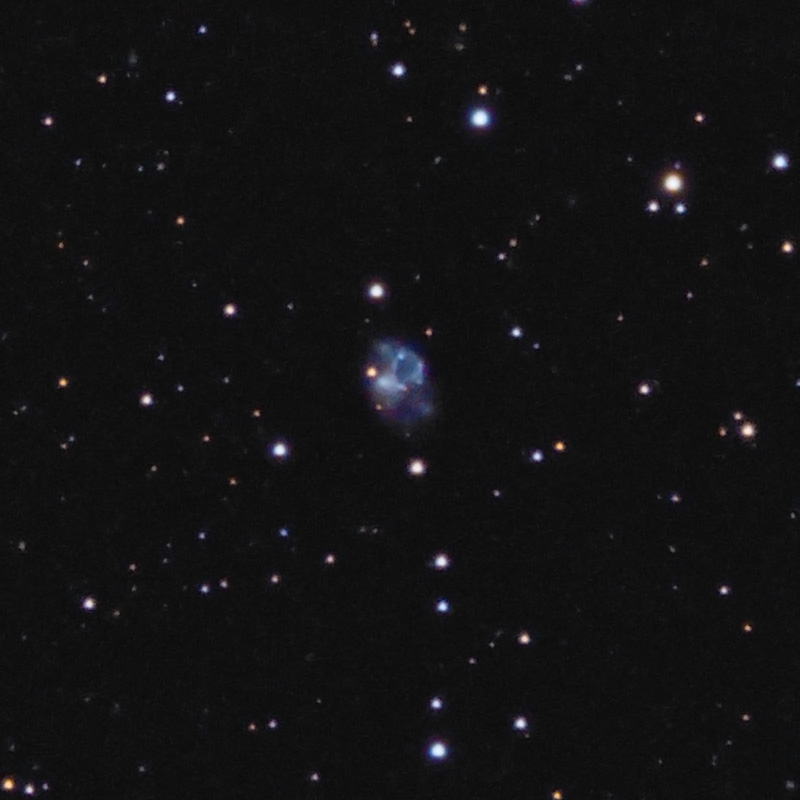
PGC37680L4X10RGB1X20R-CROP125.jpg
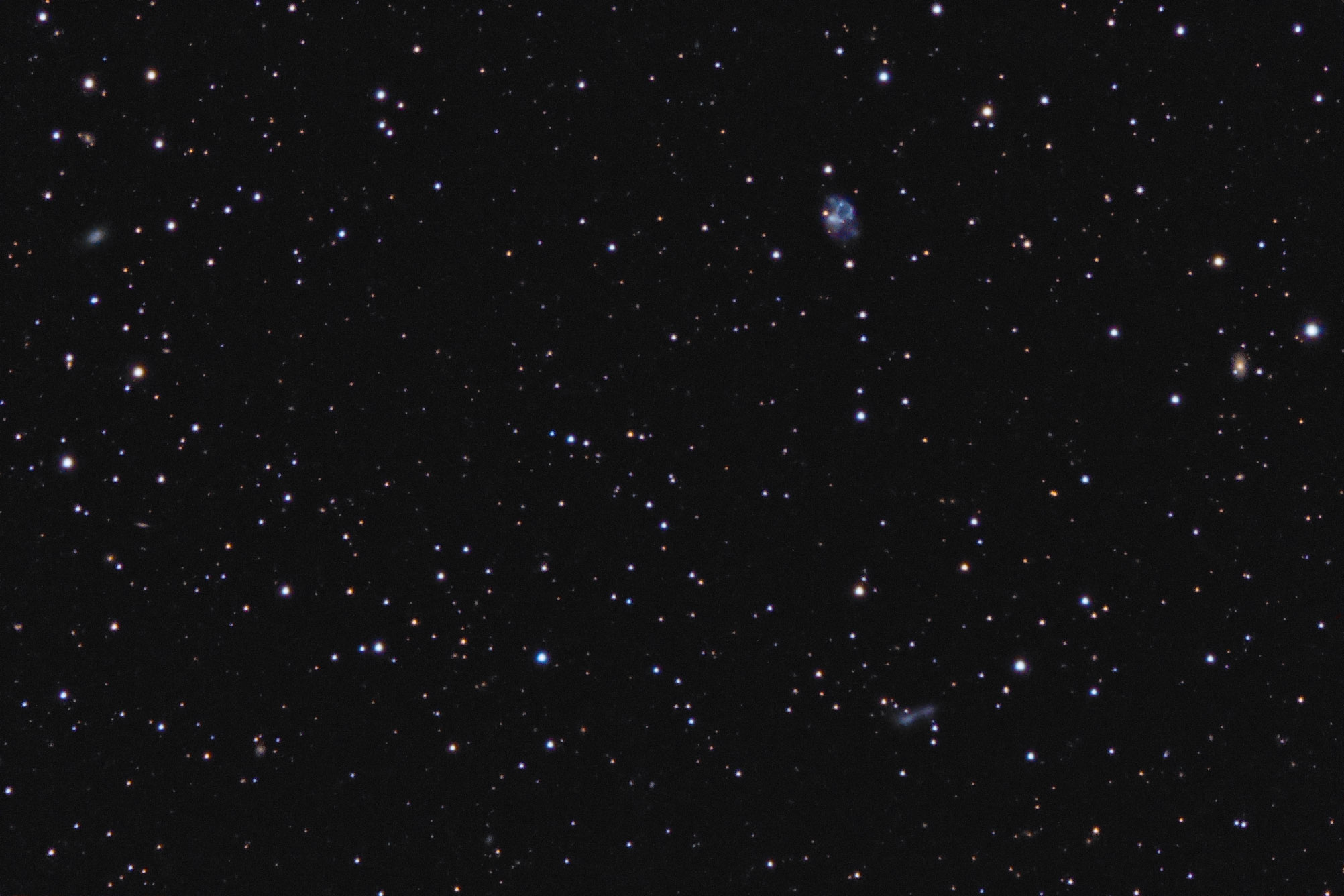
PGC37680L4X10RGB1X20R.JPG
| DeHt4 is a rather newly discovered planetary nebula in Aquila. As far as I can tell the only other amateur image of it was taken by Derek Santiago in narrow band using 8 hours of H alpha data. My image was taken trying to prove or disprove a second nebula in his image that turned out to be a likely reflection of a 5th magnitude star. It sent some nasty junk into my image but not in the form of a nebulous patch, just strong glare which GradientXTerminator easily removed.
Unfortunately, my camera has about twice the read noise of his. For LRGB images this isn't very meaningful but for trying for something this faint it becomes very important. Also, my Ha sensitivity was about half of his as well. Then he used one hour exposures which helps negate read noise issues. Since my scope, even with temperature compensation can't hold focus for more than 30 minutes I had to live with that limitation. In fact, half the data was taken in 20 minute subs as it was a warm night and I couldn't cool any lower than -20C and had only 20 minute darks for that temperature. A second night was cooler allowing my usual -25C summer subs for which I did have 30 minute darks. You can easily see he picked up a lot more detail in the faint regions thanks to his lower read noise issues and higher response at the Ha emission line. A third night of horrid transparency was used for the color data which is pathetic. I thought I could make it work but not really. It was used for the stars, not the nebula as it didn't register but for a hint of it in the brightest part of the nebula on the western side.
The dark vertical nebula coming up from the bottom right is the top part of LDN 698. With nothing else to identify I didn't prepare an annotated image.
For details on the nebula, I'll refer you to Derek's post at: http://www.pbase.com/image/160770690
Derek's size measurements are very similar to mine. That gives a size of 6.6x4.5 light-years assuming the stated distance of 14,370 to 18,256 is correct (using the 14,370 figure). That is very large for a planetary and argues that this distance is well overstated. How much I don't know. The authors of the paper Derek sites admit this possibility. Note the planetary is #4 in the paper which covers 5 similar planetary nebulae.
For those always claiming I go deep because of my large aperture note that Derek used a scope with only 43% the light grasp I have yet picked up more detail in the faintest parts of the image. Also, he was working from the bright skies of Morristown, NJ. Thanks to the power of narrow band that was hardly an issue for him.
To see how faint this one is here's a link to the red POSS 2 plate of the region: http://stdatu.stsci.edu/cgi-bin/dss_search?v=poss2ukstu_red&r=19+26+26.66&d=%2B13+19+34.7&e=J2000&h=15.0&w=15.0&f=gif&c=none&fov=NONE&v3=
14" LX200R @ f/10, L=4x10'+Ha4x30'+Ha6x20' R=2x10'+.8 x total Ha G=2x10' B=2x10'+.25 x total Ha, STL-11000XM, Paramount ME Related Designations for DEHT4DEHT4, | 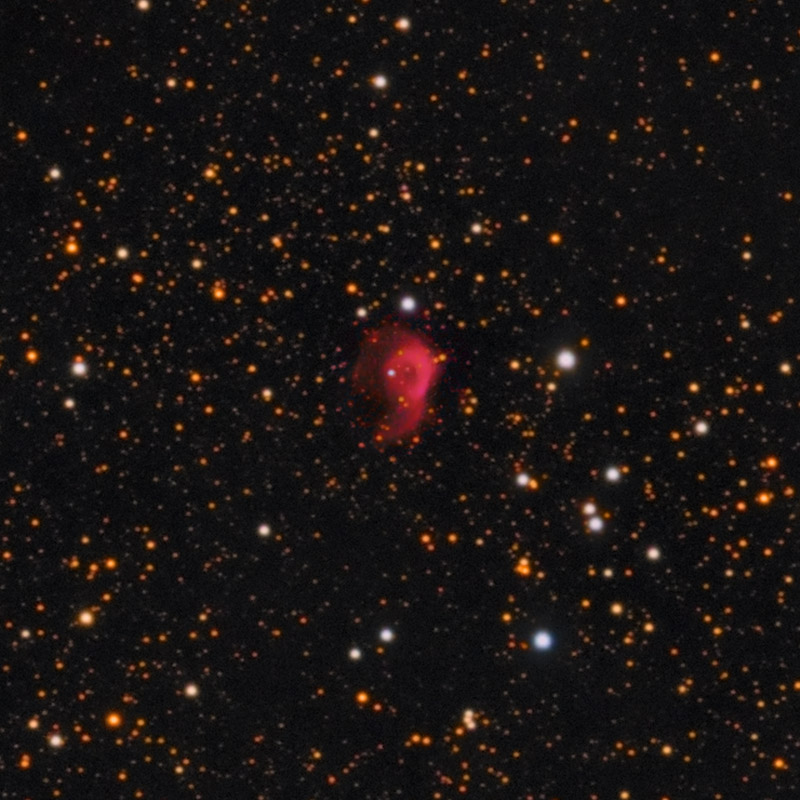
DEHT4L4X10HA4X30HA6X20RB2X10G1X10R1-125.JPG
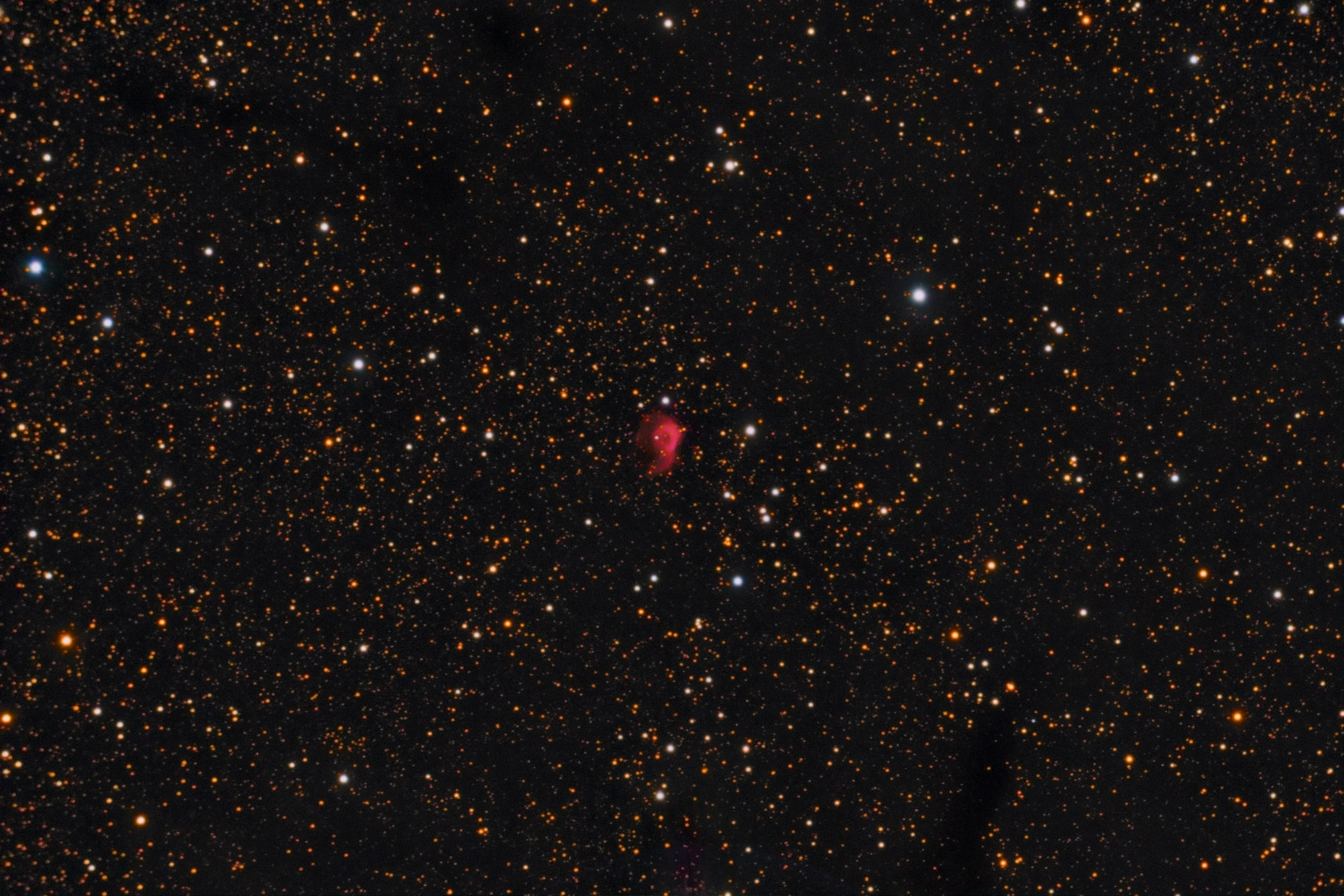
DEHT4L4X10HA4X30HA6X20RB2X10G1X10R1.JPG
| DG 170 is a small reflection nebula in the Cygnus Rift. Unlike most reflection nebulae it is both a bit orange and faded blue in color rather than bright blue as are the other two reflection nebulae in my image. I saw it faintly in the H alpha filter but not strong enough to add that to this image so it is pure LRGB. At the lower left end (southeast) is an orange star that may be the cause of the orange parts of the nebula if it is slightly in front of the cloud. Sticking out of its lower left side is a faint orange-red blob. This was fairly strong in my single H alpha image and is HH899 a hydrogen jet from a protostar. Likely not the orange star. The dust cloud obscures an open cluster known as the "NAME [C86] L988 e Cluster" at SIMBAD. There you can find a 2MASS deep IR image showing the cluster that is mostly invisible in visible light. The default is the visual light image so click the 2MASS button for the IR image.
The reflection nebula below is DG 170 that is mostly a blue bar above a blue star is DG 171. The larger and brighter reflection nebula to the right deep in a dark nebula is DG 169. The dark cloud appears to be DOBASHI 2870.
I was first drawn to this field by an Italian Master's student who was doing a thesis that somehow involved an object she called [B77] 32. Not having the faintest idea what that was and sure I'd not taken it I told her sorry but I'd not taken an image of it and forgot about it. A year or two later I saw that email and looked further and saw it at SIMBAD under the DG 170 designation and added it to my to-do list. Then a few weeks ago I saw this field as a small part of a wide angle shot posted in the Cloudy Nights forum https://www.cloudynights.com/topic/584469-cygnus-dark-nebulae-field-ldn-998 . That caused me to up its priority on my to-do list and on a questionable night cut short by clouds the computer obtained this image. I'd scheduled some Ha data but all but 10 minutes of that was blocked by clouds. I decided that showed the H alpha to be so weak it wasn't worth trying again and went with what you see here.
14" LX200R @ f/10, L=4x10' RGB=2x10', STL-11000XM, Paramount ME Related Designations for DG170DG170, | 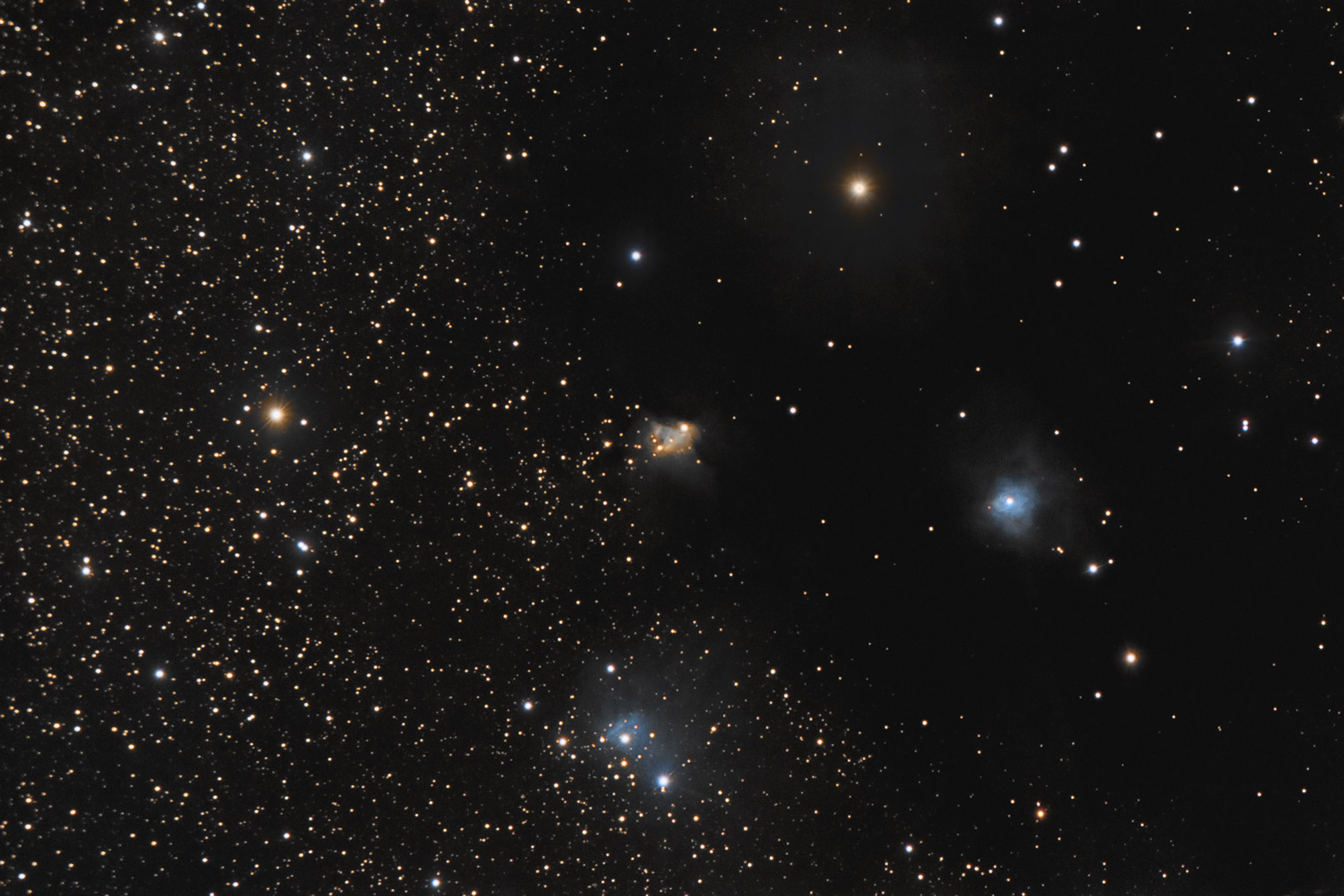
DG170L4X10RGB2X10.JPG
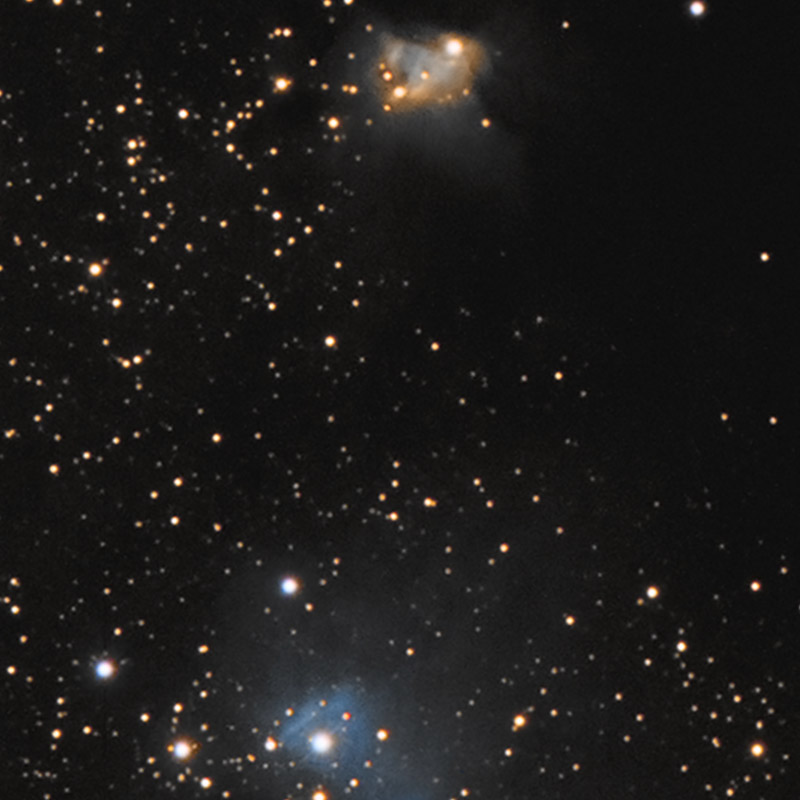
DG170L4X10RGB2X10CROP150.JPG
| 















